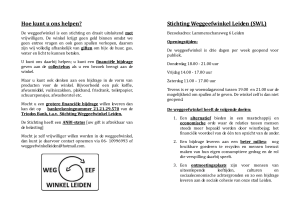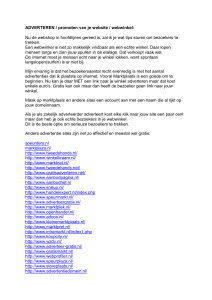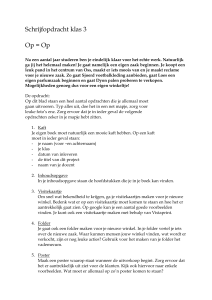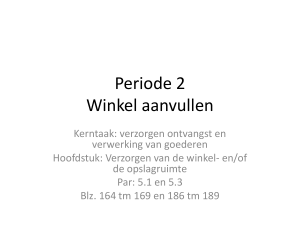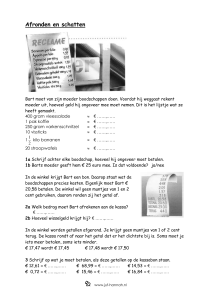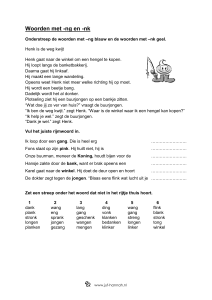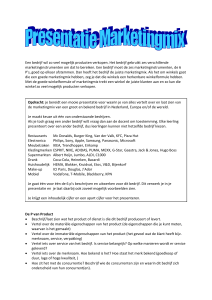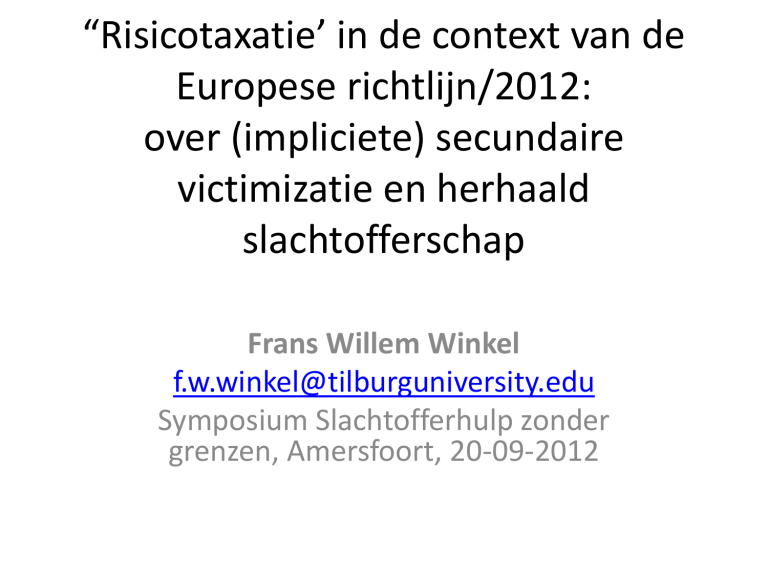
“Risicotaxatie’ in de context van de
Europese richtlijn/2012:
over (impliciete) secundaire
victimizatie en herhaald
slachtofferschap
Frans Willem Winkel
[email protected]
Symposium Slachtofferhulp zonder
grenzen, Amersfoort, 20-09-2012
Victimologie: drie-stromenland
• Normatief perspectief (1): beweging gericht
op slachtoffer-vriendelijk maken van het
strafrecht;
• Epidemiologisch perspectief (2): slachtofferenquêtes ,
• Psychologische victimologie (3) :
Psychotraumatologie, toegespitst op
slachtoffers van misdrijven
Overeenkomsten, maar ook
verschillen
• Bij (3) staat de “psychologische methode”
centraal, bij voorbeeld:
– Is “X” een risicofactor: prospectief onderzoek
– Gebruik van instrumenten met “bewezen”
psychometrische kwaliteiten ( betrouwbaarheid,
predictieve validiteit): partnergeweld middels
victimization survey versus CTS (Conflict Tactics Scale)
– Effect (van interventie): RCT
• Conceptualisering van centrale theoretische
constructen: bij voorbeeld secundaire
victimisatie
Secondary victimization:
• Bij (1) en (2): shortcut voor een gebrek aan
compassie / empathie; afwezigheid van
respectvolle bejegening; victim blaming door
significante anderen (non-issue), politie, justitie (
= richtlijn), etc.
• Bij (3): Systematisch onderzoek van
• Impliciete secundaire victimisatie, tijdens
slachtofferverhoor door politie;
• Secundaire traumatisering (bij voorbeeld na
spreekrecht): ernstiger trauma-symptomen na
zitting
Implicit secondary victimization
• Sommige slachtoffers roepen kennelijk
gemakkelijk het vermoeden op dat zij een
valse verklaring afleggen;
• Dat vermoeden komt onbewust (impliciet) tot
stand
• Dat vermoeden is gebaseerd op irrelevante
slachtofferkenmerken:
• Ergo: onterechte twijfel aan de
geloofwaardigheid van het slachtoffer
Gepercipieerde geloofwaardigheid:
Twee-kanalen model
Verwerking van verbale
informatie
Traag, expliciet,
Cognitief kanaal
Impressievorming:
- Waar / onwaar
- Geloofwaardig /
- ongeloofwaardig
Slachtofferverhoor
door politie
Verwerking van nonverbale
informatie
Snel, impliciet,
Affectief kanaal
Risicofactoren: empirische evidentie
• Nonverbaal gedrag – de manier waarop de
verklaring door het het slachtoffer wordt afgelegd
– is een risicofactor voor secundaire victimisatie
• Voorbeelden:
– (PTSD gerelateerde) stijlen van nonverbale
communicatie: emotioneel expressieve (hyper-arousal
subtype) versus emotioneel gecontroleerde stijl
(dissociatieve PTSD)
– Cultureel bepaalde stijlen van nonverbale presentatie:
Zwart nonverbaal gedrag (“wegkijken”) van Surinaamse
slachtoffers
• “affect precedes cognition”: trauma-gericht verhoor
Secondary traumatization =
(CJS-)Secondary victimization, vanuit
een trauma-perspectief: bij voorbeeld
ernstiger PTSS-symptomen na de
strafzitting dan daarvoor.
PTSD subtypes:
• Psychotraumatologie:
• Partieel (volledig; fullblown): niet voldoen aan alle
DSM-criteria, waar onder stressor criterium (w.o. DSM
5 suggestie: aanpassings-stoornis na blootstelling aan
niet-trauamtische stressor)
• Enkelvoudig (complex; met co-morbiditeit)
• Hyper-arousal versus Dissociative subtype (ASD in IV)
• Delayed (versus non-delayed) onset; Acute PTSD (vs.
Acute Stress Stoornis: ASD)
• C-PTSD: welke subtypes?????
C-PTSD subtypes: which ones?
PTSD
Subtypes:
Internalizing
Symptomatology
Externalizing
Symptomatology
Hopelessness
Syndrome
(DSM- mood
disorder/depression)
Helplessness
Syndrome
Embitterment
Syndrome
False-alarm
Syndrome
(DSM- Anxiety / Anger
disorder
Panic
Syndrome
(“stockholm”)
Explosive
Syndrome
Peritraumatic escalation, cognitive inversion, and Shattered
Illusions (SIM).
Peritraumatic escalation:
Fight-flight response failure
Emotional
Implosion:
Extreme anxiety /
Tonic Immobility
Emotional
Explosion:
Blind anger /
Rage
Psychotic
Dissociation
Dysregulated
Emergency-response:
Hyperalert / paranoid behavior:
In standby mode
False alarm-syndrome /
Internalizing symptoms:
Self as easy target bias,
Anxiety, Propensity to
panic
Avoidant / Submissive Behavior
Cognitive cascade:
Inversion; SIM)
False alarm-syndrome /
Externalizing symptoms:
Hostility bias, anger,
Propensity to explode in response to
subjective danger-signals
Impulsive agressive behavior
PE – geïnduceerde ontregeling
‘alarmsysteem’ : naar Brewin
Peritraumatische escalatie (PE)
Dissociatieve toestand
“selectieve ontsluiting”
Verbaal toegankelijk
geheugen
Oververzadiging:
Geconditioneerde
Schrik triggers
Situationeel toegankelijk
geheugen
Schrik-reflex lijkt
“uit het niets” te komen
Alarm-systeem: ontregelde noodreactie
Secondaire traumatisering:
samenvatting
• Recent Intervict-onderzoek (Lens, Pemberton,
Groenhuijsen, 2010) suggereert dat de groep
“sprekers” voor een zeer belangrijk deel bestaat
uit slachtoffers, die voldoen aan de criteria voor
een chronische PTSS
• Voorts: spreken draagt niet bij aan emotioneel
herstel (echter: TSQ ligt minder voor de hand dan
de DTS)
• Her-analyse van bedoeld data-bestand
suggereert, echter:
PTSS: conditionele risicofactor
• PTSS is een risico-factor voor secundaire
traumatisering,
• Dat geldt bij uitstek voor slachtoffers die voor de
zitting last hebben van een verbitterings- of een
explosief syndroom
• Empirische evidentie (volgende dia) suggereert
namelijk dat “sprekers” (vs. “niet-sprekers”) meer
woedesymptomen rapporteren na (versus voor)
de zitting; en dat woede een onafhankelijke
predictor voor posttrauamtische
symptomatologie na de zitting
Anger-dysregulation- scores
24
21.64
22
20
18
16.92
Impact statement (high effort)
16.39
Non-participant (low effort)
16
14.02
14
12
10
Pre-trial
Post-trial
Interaction-term: F1,74 = 4.04; p < .05
Predictors of T1 posttraumatic
symptomatology (TSQ, after trial)
Predictors
β
t
p
TSQ Intrusion
.43
6.84
< .05
TSQ Arousal
.37
5.67
< .05
Anger
dysregulation
.11
2.28
< .05
Control over
recovery
- .14
- 3.13
< .05
.02
.57
Revenge (step
2: r = .25**)
n.s.
Herhaald slachtofferschap: RTI’s
• In de forensische psychologie zijn diverse
risicotaxatie-instrumenten ontwikkeld, gericht op
het identificeren van de kans op recidive bij
partnergeweld:
• Voorbeelden: DVRAG / ODARA (actuarieel) en
• SARAG / Bsafer (niet-actuarieel).
• Echter: voor het identificeren van slachtoffers die
in gevaar verkeren – een verhoogd risico lopen
om opnieuw op korte termijn slachtoffer te
worden, kan……
Vervolg: met dank aan SASS
• Niet worden volstaan met de afname van de
klassieke forensische instrumenten, maar kan
beter gebruik worden gemaakt van de Danger
Assessment Inventory (DAI).
• De DAI omvat naast de klassieke forensische
risicofactoren, mede:
• Slachtofferkenmerken (w.o. PTSS)
• en Scenario-kenmerken (wederkerig versus
eenzijdig geweld)
• Verhoogde predictieve validiteit (t.a.v. herhaald
slachtofferschap)
Danger Assessment Inventory:
screening version for police and victim support workers
Danger Assessment Inventory
Perpetrator features
ODARA-score > 7
YES =1
Victim features
Involvement in a
Post Traumatic
Cycle (TSQ/CTS-V): Yes = 1
High risk of short-term revictimization
N=3
Scenario-features
Mutual scenario, incl.
Posttraumatic aggression
(CTS-P): Yes =1
Slotconclusie:
• Bij de implementatie van de nieuwe richtlijn dient
nadrukkelijk(er) rekening te worden gehouden
met de bijzondere positie van getraumatiseerde
slachtoffers,
• Evidentie suggereert immers dat PTSS een
(conditionele) risicofactor voor
• Herhaald slachtofferschap van (ook publiek
geweld; Kunst & Winkel, 2012) geweldsmisdrijven
• Secundaire traumatisering na uitoefening
spreekrecht, en
• Impliciete secundaire victimisatie (bij verhoor)
Enkele Referenties:
Kunst, M.J.J., Winkel, F.W., & Bogaerts, S. (2011).
Posttraumatic anger, recalled peritraumatic emotions, and post traumatic stress disorder (PTSD)
in victims of violent crime, Journal of Interpersonal Violence, 2011, 26, 17, 3561 – 3579
Kuijpers, K.F., Van der Knaap, & Winkel, F.W.
PTSD symptoms as risk factors for intimate partner violence revictimization and the mediating
role of victims' violent behavior, Journal of Traumatic Stress, 2012, 25, 179 – 186.
Winkel, F.W. (2009).Fear of crime (type A) revisited: predicting panic disorder and persistent panic
and fear symptoms following criminal victimization. International Perspectives in Victimology,
2009, 4, 1, 35 – 42.
Winkel, F.W. Identifying domestic violence victims at risk of hyperaccessible traumatic memories
and / or re-victimization: The predictive performance of the Scanner and the B-Safer. In: Baldry,
A.C., & Winkel, F.W. (Eds.). Intimate partner violence prevention and intervention: the risk
assessment and management approach. Hauppage, NY : Nova Science, 2008, pp. 61 – 83.
F.W. Winkel, A. Vrij, L. Koppelaar & J.C. van der Steen
Reducing secondary victimisation risks and skilled police intervention: enhancing the quality of
police - rape victim encounters through training-programmes, Journal of Police and Criminal
Psychology, 1991, 7, 2, 2-11.
Winkel, F.W. (2007) Post traumatic anger: Missing link in the wheel of misfortune. Nijmegen: Wolf
Winkel, F.W., Wohlfarth, T. & Blaauw, E.
Police based early detection of Type A trauma symptomatology in crime victims: the validity of rapid,
objective risk assessment. International Journal of Law and Psychiatry, 2003, 26, 191 – 206.
Wohlfarth, T. D., Van den Brink, W., Winkel, F.W., & Ter Smitten, M.
Screening for posttraumatic stress disorder: An evaluation of two self-report scales among crime
victims. Psychological Assessment, 2003, 15, 1, 101 - 109.
Winkel, Frans Willem A frustration / negative cue model of unfavorable police treatment of black
citizens. Discrimination based on automatic and biased signal processing. International Journal of Law
and Psychiatry, 1999, 22, 3-4, 273 - 287.
Mulder, M.R. & Winkel, F.W.
Social workers' and police officers' perceptions of victim credibility: perspective-taking and the impact
of extra-evidential factors. Psychology, Crime, and Law, 1996, 2, 307 - 319.
A. Vrij & F.W. Winkel Perceptual Distortions in Crosscultural Interrogations: the Impact of Skin Colour,
Accent, Speech Style and Spoken Fluency on Impression Formation, Journal of Crosscultural Psychology,
1994, 25, 2, 284 - 295
Winkel, F.W., A. Denkers & A. Vrij
The Effects of Attributions on Crime Victims' Psychological Re-adjustment. Genetic, Social and General
Psychology Monographs, 1994, 120, 2, 147 - 169.
F.W. Winkel & L. Koppelaar
Perceived credibility of the communicator: studies of perceptual bias in police officers conducting rape
interviews, in: Losel, Friedrich., Doris Bender, & Thomas Bliesener (eds.) Psychology and Law:
International Perspectives, Berlin/New York: Walter de Gruyter, 1992, 219-234.

